Travel to Argentina
Tourism , Culture and History Tour
Why Argentina ?
When talking about Argentina, inevitably appear in the imagination of gauchos and the tango, but what really attracts many travelers is its natural beauty. The variety of landscapes ranging from deserts to the northern Andes in the south, from Iguazú Falls to the desolate Patagonia. And, above all, stands Buenos Aires, the capital, a magnificent city that is surprising both for its elegance as for its neo-European culture.
In fact, the most revealing of the large number of immigrants is to see how the features of European culture have remained intact during its adaptation to the so-called New World. Therefore, Argentina is one Latin American country in which Europeans, Americans and English speakers feel at ease and go virtually unnoticed
best time travel to Argentina
For residents in the northern hemisphere, Argentina offers the attractive possibility of enjoying two summers in a year, but due to their great diversity and vast geography, it is worth visiting these lands at any time. Buenos Aires, for example, has many attractions beyond the urban stations, but to assess areas such as Patagonia or the Perito Moreno Glacier in Santa Cruz, I will take the summer months between December and February. The best time to approach the Iguazu Falls in subtropical Misiones province, is in spring or winter in the southern hemisphere, when the heat and humidity are less suffocating. During the winter (mid-June to late September) you can go skiing
Argentina Mean festivals and Holidays
Argentina holds a few festivals and holidays, and mostly have their origin in the liturgical calendar of Roman Catholics. Are centered on Christmas, New Year and Easter. Other important events are the All Saints Day and the feasts of the various provinces, as the commemoration of the May Revolution of 1810 (May 25), Malvinas Day (June 10) and Day of Race (October 12)
Argentina Most Attraction Places to Travel
Buenos Aires
For the renowned writer Jorge Luis Borges in Buenos Aires, the city was as eternal as water and air. For many Argentines, their capital is synonymous with the country itself, so much so that 40 percent of the population lives in the suburbs, in constant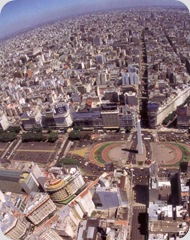 expansion, the vast metropolis. Buenos Aires is situated on the riverside of the silver in the district of the city and not, as might be thought, in the province of Buenos Aires. It is a reflection of urban Europe and its center is compact and uniform, is similar to Paris, its streets lined with trees and abundant plazas evoke a faded elegance and seductive. The city is crowded with bankers and showcases luxurious mixed with beggars and unemployed of the suburbs surrounding the city. In the urban area, the Plaza de Mayo is the main focus of activity; Avenue July 9, nearby, is known as the widest in the world, a veritable nightmare for the pedestrians, while the road is the Santa Fe perfect place for shopping.
expansion, the vast metropolis. Buenos Aires is situated on the riverside of the silver in the district of the city and not, as might be thought, in the province of Buenos Aires. It is a reflection of urban Europe and its center is compact and uniform, is similar to Paris, its streets lined with trees and abundant plazas evoke a faded elegance and seductive. The city is crowded with bankers and showcases luxurious mixed with beggars and unemployed of the suburbs surrounding the city. In the urban area, the Plaza de Mayo is the main focus of activity; Avenue July 9, nearby, is known as the widest in the world, a veritable nightmare for the pedestrians, while the road is the Santa Fe perfect place for shopping.
Among the attractions in Buenos Aires include the Catedral Metropolitana, which is the tomb of José de San Martín, hero of the struggle for national independence of Argentina and the Teatro Colon, one of the temples of opera, ballet and classical music's most prestigious the world, a number of interesting museums, among which the National Endowment for the Arts, the Film Museum and the Historic National, which provides an overview of developments in the country, the colorful Italian neighborhood of La Boca, with its housing wooden striking colors along the channel of the Riachuelo and the Recoleta Cemetery.
the National Endowment for the Arts, the Film Museum and the Historic National, which provides an overview of developments in the country, the colorful Italian neighborhood of La Boca, with its housing wooden striking colors along the channel of the Riachuelo and the Recoleta Cemetery.
Whether you are staying in a modest or luxurious hotels, it is possible to stay in the heart of the city. The congressional district is a good place to sleep at a reasonable price, while the average cost of hotels are concentrated on Avenida de Mayo. In the districts of La Boca and San Telmo quantities can be eaten by small. In the center, Lavalle and Avenida Corrientes are the places suitable to consume pizza, drink coffee with the local intellectuals or enjoy one of the popular meat dishes.
The River Plate
For the inhabitants of Greater Buenos Aires, summer is synonymous with beach, the river plate is usually the favorite destination of Buenos Aires. Located in the North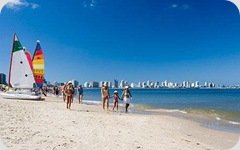 Atlantic coast, 400 km from the capital, beaches stretching along 8 km, as well as the elegant mansions that reflect the aristocratic origins of the area and are interspersed with the properties of the new middle class . Sea lions observed closely the activities of fishing piers, and a replica of the Grotto of Lourdes (France) is an interesting space to explore.
Atlantic coast, 400 km from the capital, beaches stretching along 8 km, as well as the elegant mansions that reflect the aristocratic origins of the area and are interspersed with the properties of the new middle class . Sea lions observed closely the activities of fishing piers, and a replica of the Grotto of Lourdes (France) is an interesting space to explore.
Cordoba
Argentina's second city, Cordoba, has long competed with Buenos Aires for political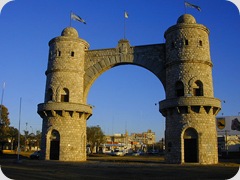 supremacy, economic and cultural, indeed languished while the city for negligence, Cordova became the architectural jewel of the country. Currently, in the dense center of the metropolis there is a valuable collection of colonial buildings, the old market, the Cathedral and the Church of the Society of Jesuits. The provincial museum of Sobremonte Marquis is one of the most important historical museums in the country.
supremacy, economic and cultural, indeed languished while the city for negligence, Cordova became the architectural jewel of the country. Currently, in the dense center of the metropolis there is a valuable collection of colonial buildings, the old market, the Cathedral and the Church of the Society of Jesuits. The provincial museum of Sobremonte Marquis is one of the most important historical museums in the country.
La Pampa
The vast plains of the Pampa is the most important agricultural center of Argentina and the origin of the symbol of romantic nationalism, the gaucho. This area includes the provinces of Buenos Aires, La Pampa and much of Santa Fe and Cordoba, among its many surrounding wooded hills rise, vast prairies and lakes filled with salt water flamencos. Calel Lihué The National Park is a popular spot, its fauna including some puma and many guanaco, rhea, native hares and a variant of wild chinchilla called vizcacha. It is worth visiting the cities of La Plata, Luján (whose basilica dedicated to Our Lady of Luján receives four million pilgrims a year), Rosario and Santa Fe, recognized for its many museums, churches and colonial buildings decaying.
Iguazu Falls
Located in the Parque Nacional Iguazú near Puerto Iguazú, these spectacular falls are just east of the confluence of the Iguazú and Paraná rivers. At least five thousand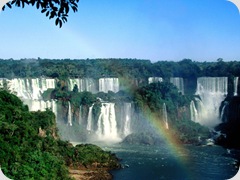 cubic meters of water falling sharply from 70 m to the bottom. Tourists may find familiar, as it were the scene of the film The Mission. The area has historic ruins of the Jesuit missions, which are another attraction for many travelers, the best known are those of San Ignacio Mini, a building known as the Baroque style Guarani. Above the falls you can go canoeing or kayaking and other water sports practice. The park surrounding the falls is formed by 55,000 hectares of pristine tropical forest, with flora and fauna abundant and varied.
cubic meters of water falling sharply from 70 m to the bottom. Tourists may find familiar, as it were the scene of the film The Mission. The area has historic ruins of the Jesuit missions, which are another attraction for many travelers, the best known are those of San Ignacio Mini, a building known as the Baroque style Guarani. Above the falls you can go canoeing or kayaking and other water sports practice. The park surrounding the falls is formed by 55,000 hectares of pristine tropical forest, with flora and fauna abundant and varied.
Cuyo
The region covers the Cuyo Andean provinces of Mendoza, San Juan and San Luis. This area retains a strong regional identity, with a unique mestizo population,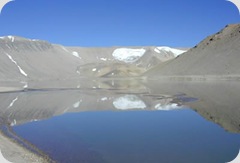 due to the influence of Chile, its neighbor. It is an agricultural region famous for its grapes and wines, situated in the shadow of the vast mountains of the Andes, where travelers can find many sports and recreational activities such as climbing and trekking. The cellars, the people hiding in the mountains and the centers of Mendoza and San Juan are other attractions of this place.
due to the influence of Chile, its neighbor. It is an agricultural region famous for its grapes and wines, situated in the shadow of the vast mountains of the Andes, where travelers can find many sports and recreational activities such as climbing and trekking. The cellars, the people hiding in the mountains and the centers of Mendoza and San Juan are other attractions of this place.
Andean Northwest
This is the most traditional of Argentina, with its abundant natural beauty and its vestiges of pre-Columbian and colonial past. Andean Northwest covers the provinces of Jujuy, with many stocks of animals, Salta, where the best preserved colonial city in the country, hundreds of archaeological sites and buildings from the era of domination, Tucumán, La Rioja, Catamarca and Santiago del Estero .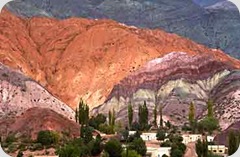
Patagonia
This enormous region south of the province of Buenos Aires has a mountainous interior with scattered glaciers, a unique coastal wildlife and Andean national parks. Peninsula Valdes is a particularly good for wildlife lovers, there live many lions and elephant seals, guanacos, rheas, Magellanic penguins and whales. Perito Moreno Glacier in Santa Cruz is a river 60 meters of ice that rises, falls and then explodes, but several years ago that has stopped expanding. Carmen de Patagones is a beautiful colonial city that survives on the trail left by ancient inhabitants of the Welsh region, particularly in the town of Gaiman.
Tierra del Fuego
Argentina shares half of its territory in the southern islands of the Atlantic Ocean with Chile. It is a place where many oil drilling rigs, sheep, glaciers, wind and waterways.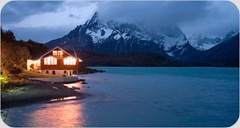 Ushuaia and Rio Grande are the two largest cities, the main attractions of the province are its magnificent landscape, its wildlife and fishing tours. The only coastal national park in Argentina includes rivers, lakes, forests and glaciers, which provide many opportunities for trekking and cover all types of animals
Ushuaia and Rio Grande are the two largest cities, the main attractions of the province are its magnificent landscape, its wildlife and fishing tours. The only coastal national park in Argentina includes rivers, lakes, forests and glaciers, which provide many opportunities for trekking and cover all types of animals
Argentina activities
Football is by far the sport with more viewers and fans in the country. Argentina also has many other specialties, among which the trekking, skiing and water activities. Elite sports such as rugby and polo, reflecting the momentum of the immigrant societies, and skiing, despite its cost, is becoming increasingly popular. Currently, Argentina is among the best places in the world of practice, many stations have specialized schools. Among the most recommended highlights the Cuyo region to the south, the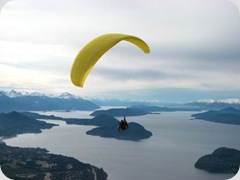 lake district, La Hoya and, nearby, Ushuaia, Tierra del Fuego.
lake district, La Hoya and, nearby, Ushuaia, Tierra del Fuego.
The walks in the mountains are also very popular, there are extensive walks with beautiful scenery through the Andes, the Sierras de Córdoba and Sierra de la Ventana, Province of Buenos Aires. Climbers should head to Aconcagua, west of Mendoza, the Fitzroy Range in Parque Nacional Los Glaciares in Santa Cruz province, and the Sierra de la Fentanes (for experienced hikers). The rafting is becoming increasingly popular in the channels that descend from the Andean divide, among the most interesting are the Mendoza and Diamante rivers in the region of Cuyo and the Hua Hum and Meliquina, near San Martin de los Andes, and the rivers Limay and Manso near Bariloche
Argentina History
The pre-Columbian Argentina was populated by sedentary indigenous groups, such as Diaguita, but also by nomadic tribes who lived by hunting. Their resistance slowed Spanish incursions, hindering settlement. Buenos Aires was not founded until 1580 and remained a wasteland during two hundred years. It was not possible to exploit the indigenous population, which was becoming more limited and was distributed as inequitable, and this led to the creation of huge cattle ranches, known as haciendas, genesis of the legendary gaucho and source of wealth for the few fortunate.
Buenos Aires became the capital of the new Viceroyalty of Río de la Plata in 1776, which marked the fourth viceroyalty that Spain established in South and Central America. In May 1810 there was the May Revolution, which led to independence six years later. The new situation has revealed strong regional disparities which Spanish rule had obscured. The Federalists of the interior (conservative landowners, supported by the gauchos and rural working class) advocated provincial autonomy, while the Unitarianism of Buenos Aires (cosmopolitan citizens who welcomed the onslaught of ideas, capital and European immigrants) support the central authority of their city. After a disastrous period under the tyrannical government of course federalist Juan Manuel Rosas, Buenos Aires and prevailed and Unitarianism, Unitarianism to the Constitution of 1853, began a new era of growth and prosperity.
Sheep were introduced, and the Pampa was devoted to the cultivation of cereals. European immigration, foreign capital and trade laid the foundations of the new liberalism. However, excessive interest on external debt increased the vulnerability of the domestic economy against the global economic crisis, wealth is concentrated in the hands of a few and increased unemployment rates, as small properties, and farmers went bankrupt and ranchers were forced to leave the field and go to the cities.
The first decades of the twentieth century were marked by a civilian government increasingly weak, the economic crisis and the continuing resentment of the elite landowners. This led the military coup of 1943, which facilitated the appearance of a political figure of Juan Domingo Peron, who was elected president in 1946 and for the second time in 1951. Together with his equally popular and charismatic wife, Eva Duarte (Evita), implemented a strict economic program based on the national industrialization and self-determination, which attracted both the conservative nationalism and the working class. A military uprising in 1955 ended his second term and forced Perón into exile in Spain, was the beginning of thirty years of disastrous military rule, interrupted only by brief periods of civilian command. Perón returned to power in 1973, but for a very short time, and who died a year later, bequeathing the presidency to his third wife, Isabel Martínez. The growing economic and political instability led to an era of strikes, political kidnappings and guerrilla warfare. Isabel's government fell in 1976, and the military instituted a reign of terror.
The years from 1976 to 1983 have been described as the years of the Dirty War. The paramilitary death squads which operated in complicity with the government, opposition and eliminate any hint of criticism extinct, causing the disappearance of between 10,000 and 30,000 citizens. The symbol of resistance to this period are the Mothers of the Plaza de Mayo, women who had the courage publicly to ensure the missing members of their families, and continued (and still) looking for and demanding justice tirelessly.
This dramatic situation came to an end with the war in the Falklands in 1982. Gen. Leopoldo Galtieri seized the islands to the British to divert international attention from political corruption and economic mismanagement in Argentina. The waves of nationalism resulted in a British fleet across the ocean to save one of the few coveted pieces remaining on the map. United Kingdom ended up being the winner in what was a shameful episode and costly for both countries. However, ownership of the Falklands remains under discussion. In June 1995, the Argentine foreign minister has proposed buying the island, offering its residents $ 800,000 for their nationality. The matter is complicated further by the belief that the British territory oilfields there and it seems likely that disputes will continue.
The ignominious collapse marked the national and international destination of the military government of Argentina and the country returned to the 1853 Constitution. The former Peronist president, Carlos Menem, has carried out important economic reforms such as privatization of state industries and opening the economy to foreign investment, reducing inflation from 5000 percent to the current rate of 1 per cent. On June 7, 2001, Menem was detained for his alleged involvement in illegal arms sales to Ecuador and Croatia during the nineties. The president Fernando de la Rúa, the Alianza UCR center-left, was elected in 1999 for a period of four years, promised to fight corruption as well as implementing stringent fiscal measures to balance Argentina's budget. But after four years of recession and an unemployment rate of over 20% of Argentines said enough. Austerity plans Fernando de la Rúa provoked strikes and demonstrations throughout the country that turned violent after the government decreed harsh measures concerning the withdrawal of money from banks. Argentina was plunged into a major economic and political confusion in December 2001 for non-payment of the loan (the largest in history) of 132,000 million dollars. De la Rua and many of his ministers resigned from rioting, looting and widespread civil unrest that resulted in 27 casualties.
On January 1, 2002 Eduardo Duhalde was elected the fifth president of Argentina. Peronista adamant, is characterized by populism and protectionism, although most critics do not forget the scandals that marred his tenure as governor of Buenos Aires. One of his first actions was to remove the convertibility of the peso pegged to a rate of one-to-one with the dollar almost immediately the currency was devalued by over 50%. This measure was unpopular but necessary to ensure new aid from the International Monetary Fund.
After its devaluation, the peso behaved better than expected in the currency market. Duhalde plans to introduce profound changes in the Argentine government, including the transformation of the current presidential system into a parliamentary democracy, were ruined by the lack of popular support for his government. It continued to produce numerous strikes and labor disputes almost daily and many people moved by the frustration of not being able to access your money, robbed the banks.
The presidential elections in early 2003 came the surprise of the year: the former president Carlos Menem resigned in favor of Néstor Kirchner
Argentina Culture and people
European influences have permeated art, architecture, literature and lifestyle Argentines. However, particularly in the field of literature, has developed a multicultural exchange, because Argentina has offered to the world renowned authors such as Jorge Luis Borges, Julio Cortazar, Ernesto Sabato, Manuel Puig and Osvaldo Soriano. Many Argentines studied in Europe and one of its consequences was that Buenos Aires consciously emulated the artistic, musical and architectural from the European continent. Therefore, the city has numerous museums and art galleries and importance of community theater with a deep-rooted. The film has also shifted Argentina's borders, and has been used to erase the horrors of the Dirty War, which now begins to be reflected in all its cruelty in some of his films.

The sample of popular culture Argentina best known is the tango, a dance and music which have captivated the imagination of romantics worldwide. Moreover, the country's folk music. For Argentines, the sport is essential, football is a national obsession than a game. Argentina won the World Cup in 1978 and 1986, and the exploits of Diego Armando Maradona, one of the most popular Argentine since Che Guevara, have been busy soccer fans, paparazzi and columnists in the last ten years.
Roman Catholicism is the official religion of the state is dotted with popular beliefs which diverge from official doctrine. Spiritualism and the veneration of the dead are deeply rooted.
The official language is Spanish, although some communities retain their own language as a symbol of identity. The Italian is widespread, reflecting the influence of the largest group of immigrants in the country. There are 17 native languages, which include Quechua, Mapuche, Guaraní, and the tuffs Matacos.
The Argentine meat dominates the menu, and beef in this country means beef. We recommend asking the grill, which includes virtually all parts of the animal: tripe, intestines, udders ... An alternative is the typical Italian dishes like gnocchi. It also highlights the exquisite Argentinean ice cream, which again reflects the Italian influence. Share mate (infusion) with friends is a ritual, and the fact that someone is offering you a way of being accepted into the group. The yerba mate, a variety of holly, is preparing a very elaborate and takes his own vessel, known by the same name
Argentina MAP

Tourism , Culture and History Tour
Why Argentina ?
When talking about Argentina, inevitably appear in the imagination of gauchos and the tango, but what really attracts many travelers is its natural beauty. The variety of landscapes ranging from deserts to the northern Andes in the south, from Iguazú Falls to the desolate Patagonia. And, above all, stands Buenos Aires, the capital, a magnificent city that is surprising both for its elegance as for its neo-European culture.

In fact, the most revealing of the large number of immigrants is to see how the features of European culture have remained intact during its adaptation to the so-called New World. Therefore, Argentina is one Latin American country in which Europeans, Americans and English speakers feel at ease and go virtually unnoticed
best time travel to Argentina
For residents in the northern hemisphere, Argentina offers the attractive possibility of enjoying two summers in a year, but due to their great diversity and vast geography, it is worth visiting these lands at any time. Buenos Aires, for example, has many attractions beyond the urban stations, but to assess areas such as Patagonia or the Perito Moreno Glacier in Santa Cruz, I will take the summer months between December and February. The best time to approach the Iguazu Falls in subtropical Misiones province, is in spring or winter in the southern hemisphere, when the heat and humidity are less suffocating. During the winter (mid-June to late September) you can go skiing
Argentina Mean festivals and Holidays
Argentina holds a few festivals and holidays, and mostly have their origin in the liturgical calendar of Roman Catholics. Are centered on Christmas, New Year and Easter. Other important events are the All Saints Day and the feasts of the various provinces, as the commemoration of the May Revolution of 1810 (May 25), Malvinas Day (June 10) and Day of Race (October 12)
Argentina Most Attraction Places to Travel
Buenos Aires
For the renowned writer Jorge Luis Borges in Buenos Aires, the city was as eternal as water and air. For many Argentines, their capital is synonymous with the country itself, so much so that 40 percent of the population lives in the suburbs, in constant
 expansion, the vast metropolis. Buenos Aires is situated on the riverside of the silver in the district of the city and not, as might be thought, in the province of Buenos Aires. It is a reflection of urban Europe and its center is compact and uniform, is similar to Paris, its streets lined with trees and abundant plazas evoke a faded elegance and seductive. The city is crowded with bankers and showcases luxurious mixed with beggars and unemployed of the suburbs surrounding the city. In the urban area, the Plaza de Mayo is the main focus of activity; Avenue July 9, nearby, is known as the widest in the world, a veritable nightmare for the pedestrians, while the road is the Santa Fe perfect place for shopping.
expansion, the vast metropolis. Buenos Aires is situated on the riverside of the silver in the district of the city and not, as might be thought, in the province of Buenos Aires. It is a reflection of urban Europe and its center is compact and uniform, is similar to Paris, its streets lined with trees and abundant plazas evoke a faded elegance and seductive. The city is crowded with bankers and showcases luxurious mixed with beggars and unemployed of the suburbs surrounding the city. In the urban area, the Plaza de Mayo is the main focus of activity; Avenue July 9, nearby, is known as the widest in the world, a veritable nightmare for the pedestrians, while the road is the Santa Fe perfect place for shopping. Among the attractions in Buenos Aires include the Catedral Metropolitana, which is the tomb of José de San Martín, hero of the struggle for national independence of Argentina and the Teatro Colon, one of the temples of opera, ballet and classical music's most prestigious the world, a number of interesting museums, among which
 the National Endowment for the Arts, the Film Museum and the Historic National, which provides an overview of developments in the country, the colorful Italian neighborhood of La Boca, with its housing wooden striking colors along the channel of the Riachuelo and the Recoleta Cemetery.
the National Endowment for the Arts, the Film Museum and the Historic National, which provides an overview of developments in the country, the colorful Italian neighborhood of La Boca, with its housing wooden striking colors along the channel of the Riachuelo and the Recoleta Cemetery. Whether you are staying in a modest or luxurious hotels, it is possible to stay in the heart of the city. The congressional district is a good place to sleep at a reasonable price, while the average cost of hotels are concentrated on Avenida de Mayo. In the districts of La Boca and San Telmo quantities can be eaten by small. In the center, Lavalle and Avenida Corrientes are the places suitable to consume pizza, drink coffee with the local intellectuals or enjoy one of the popular meat dishes.
The River Plate
For the inhabitants of Greater Buenos Aires, summer is synonymous with beach, the river plate is usually the favorite destination of Buenos Aires. Located in the North
 Atlantic coast, 400 km from the capital, beaches stretching along 8 km, as well as the elegant mansions that reflect the aristocratic origins of the area and are interspersed with the properties of the new middle class . Sea lions observed closely the activities of fishing piers, and a replica of the Grotto of Lourdes (France) is an interesting space to explore.
Atlantic coast, 400 km from the capital, beaches stretching along 8 km, as well as the elegant mansions that reflect the aristocratic origins of the area and are interspersed with the properties of the new middle class . Sea lions observed closely the activities of fishing piers, and a replica of the Grotto of Lourdes (France) is an interesting space to explore. Cordoba
Argentina's second city, Cordoba, has long competed with Buenos Aires for political
 supremacy, economic and cultural, indeed languished while the city for negligence, Cordova became the architectural jewel of the country. Currently, in the dense center of the metropolis there is a valuable collection of colonial buildings, the old market, the Cathedral and the Church of the Society of Jesuits. The provincial museum of Sobremonte Marquis is one of the most important historical museums in the country.
supremacy, economic and cultural, indeed languished while the city for negligence, Cordova became the architectural jewel of the country. Currently, in the dense center of the metropolis there is a valuable collection of colonial buildings, the old market, the Cathedral and the Church of the Society of Jesuits. The provincial museum of Sobremonte Marquis is one of the most important historical museums in the country. La Pampa
The vast plains of the Pampa is the most important agricultural center of Argentina and the origin of the symbol of romantic nationalism, the gaucho. This area includes the provinces of Buenos Aires, La Pampa and much of Santa Fe and Cordoba, among its many surrounding wooded hills rise, vast prairies and lakes filled with salt water flamencos. Calel Lihué The National Park is a popular spot, its fauna including some puma and many guanaco, rhea, native hares and a variant of wild chinchilla called vizcacha. It is worth visiting the cities of La Plata, Luján (whose basilica dedicated to Our Lady of Luján receives four million pilgrims a year), Rosario and Santa Fe, recognized for its many museums, churches and colonial buildings decaying.
Iguazu Falls
Located in the Parque Nacional Iguazú near Puerto Iguazú, these spectacular falls are just east of the confluence of the Iguazú and Paraná rivers. At least five thousand
 cubic meters of water falling sharply from 70 m to the bottom. Tourists may find familiar, as it were the scene of the film The Mission. The area has historic ruins of the Jesuit missions, which are another attraction for many travelers, the best known are those of San Ignacio Mini, a building known as the Baroque style Guarani. Above the falls you can go canoeing or kayaking and other water sports practice. The park surrounding the falls is formed by 55,000 hectares of pristine tropical forest, with flora and fauna abundant and varied.
cubic meters of water falling sharply from 70 m to the bottom. Tourists may find familiar, as it were the scene of the film The Mission. The area has historic ruins of the Jesuit missions, which are another attraction for many travelers, the best known are those of San Ignacio Mini, a building known as the Baroque style Guarani. Above the falls you can go canoeing or kayaking and other water sports practice. The park surrounding the falls is formed by 55,000 hectares of pristine tropical forest, with flora and fauna abundant and varied. Cuyo
The region covers the Cuyo Andean provinces of Mendoza, San Juan and San Luis. This area retains a strong regional identity, with a unique mestizo population,
 due to the influence of Chile, its neighbor. It is an agricultural region famous for its grapes and wines, situated in the shadow of the vast mountains of the Andes, where travelers can find many sports and recreational activities such as climbing and trekking. The cellars, the people hiding in the mountains and the centers of Mendoza and San Juan are other attractions of this place.
due to the influence of Chile, its neighbor. It is an agricultural region famous for its grapes and wines, situated in the shadow of the vast mountains of the Andes, where travelers can find many sports and recreational activities such as climbing and trekking. The cellars, the people hiding in the mountains and the centers of Mendoza and San Juan are other attractions of this place. Andean Northwest
This is the most traditional of Argentina, with its abundant natural beauty and its vestiges of pre-Columbian and colonial past. Andean Northwest covers the provinces of Jujuy, with many stocks of animals, Salta, where the best preserved colonial city in the country, hundreds of archaeological sites and buildings from the era of domination, Tucumán, La Rioja, Catamarca and Santiago del Estero .

Patagonia
This enormous region south of the province of Buenos Aires has a mountainous interior with scattered glaciers, a unique coastal wildlife and Andean national parks. Peninsula Valdes is a particularly good for wildlife lovers, there live many lions and elephant seals, guanacos, rheas, Magellanic penguins and whales. Perito Moreno Glacier in Santa Cruz is a river 60 meters of ice that rises, falls and then explodes, but several years ago that has stopped expanding. Carmen de Patagones is a beautiful colonial city that survives on the trail left by ancient inhabitants of the Welsh region, particularly in the town of Gaiman.
Tierra del Fuego
Argentina shares half of its territory in the southern islands of the Atlantic Ocean with Chile. It is a place where many oil drilling rigs, sheep, glaciers, wind and waterways.
 Ushuaia and Rio Grande are the two largest cities, the main attractions of the province are its magnificent landscape, its wildlife and fishing tours. The only coastal national park in Argentina includes rivers, lakes, forests and glaciers, which provide many opportunities for trekking and cover all types of animals
Ushuaia and Rio Grande are the two largest cities, the main attractions of the province are its magnificent landscape, its wildlife and fishing tours. The only coastal national park in Argentina includes rivers, lakes, forests and glaciers, which provide many opportunities for trekking and cover all types of animals Argentina activities
Football is by far the sport with more viewers and fans in the country. Argentina also has many other specialties, among which the trekking, skiing and water activities. Elite sports such as rugby and polo, reflecting the momentum of the immigrant societies, and skiing, despite its cost, is becoming increasingly popular. Currently, Argentina is among the best places in the world of practice, many stations have specialized schools. Among the most recommended highlights the Cuyo region to the south, the
 lake district, La Hoya and, nearby, Ushuaia, Tierra del Fuego.
lake district, La Hoya and, nearby, Ushuaia, Tierra del Fuego. The walks in the mountains are also very popular, there are extensive walks with beautiful scenery through the Andes, the Sierras de Córdoba and Sierra de la Ventana, Province of Buenos Aires. Climbers should head to Aconcagua, west of Mendoza, the Fitzroy Range in Parque Nacional Los Glaciares in Santa Cruz province, and the Sierra de la Fentanes (for experienced hikers). The rafting is becoming increasingly popular in the channels that descend from the Andean divide, among the most interesting are the Mendoza and Diamante rivers in the region of Cuyo and the Hua Hum and Meliquina, near San Martin de los Andes, and the rivers Limay and Manso near Bariloche
Argentina History
The pre-Columbian Argentina was populated by sedentary indigenous groups, such as Diaguita, but also by nomadic tribes who lived by hunting. Their resistance slowed Spanish incursions, hindering settlement. Buenos Aires was not founded until 1580 and remained a wasteland during two hundred years. It was not possible to exploit the indigenous population, which was becoming more limited and was distributed as inequitable, and this led to the creation of huge cattle ranches, known as haciendas, genesis of the legendary gaucho and source of wealth for the few fortunate.
Buenos Aires became the capital of the new Viceroyalty of Río de la Plata in 1776, which marked the fourth viceroyalty that Spain established in South and Central America. In May 1810 there was the May Revolution, which led to independence six years later. The new situation has revealed strong regional disparities which Spanish rule had obscured. The Federalists of the interior (conservative landowners, supported by the gauchos and rural working class) advocated provincial autonomy, while the Unitarianism of Buenos Aires (cosmopolitan citizens who welcomed the onslaught of ideas, capital and European immigrants) support the central authority of their city. After a disastrous period under the tyrannical government of course federalist Juan Manuel Rosas, Buenos Aires and prevailed and Unitarianism, Unitarianism to the Constitution of 1853, began a new era of growth and prosperity.
Sheep were introduced, and the Pampa was devoted to the cultivation of cereals. European immigration, foreign capital and trade laid the foundations of the new liberalism. However, excessive interest on external debt increased the vulnerability of the domestic economy against the global economic crisis, wealth is concentrated in the hands of a few and increased unemployment rates, as small properties, and farmers went bankrupt and ranchers were forced to leave the field and go to the cities.
The first decades of the twentieth century were marked by a civilian government increasingly weak, the economic crisis and the continuing resentment of the elite landowners. This led the military coup of 1943, which facilitated the appearance of a political figure of Juan Domingo Peron, who was elected president in 1946 and for the second time in 1951. Together with his equally popular and charismatic wife, Eva Duarte (Evita), implemented a strict economic program based on the national industrialization and self-determination, which attracted both the conservative nationalism and the working class. A military uprising in 1955 ended his second term and forced Perón into exile in Spain, was the beginning of thirty years of disastrous military rule, interrupted only by brief periods of civilian command. Perón returned to power in 1973, but for a very short time, and who died a year later, bequeathing the presidency to his third wife, Isabel Martínez. The growing economic and political instability led to an era of strikes, political kidnappings and guerrilla warfare. Isabel's government fell in 1976, and the military instituted a reign of terror.
The years from 1976 to 1983 have been described as the years of the Dirty War. The paramilitary death squads which operated in complicity with the government, opposition and eliminate any hint of criticism extinct, causing the disappearance of between 10,000 and 30,000 citizens. The symbol of resistance to this period are the Mothers of the Plaza de Mayo, women who had the courage publicly to ensure the missing members of their families, and continued (and still) looking for and demanding justice tirelessly.
This dramatic situation came to an end with the war in the Falklands in 1982. Gen. Leopoldo Galtieri seized the islands to the British to divert international attention from political corruption and economic mismanagement in Argentina. The waves of nationalism resulted in a British fleet across the ocean to save one of the few coveted pieces remaining on the map. United Kingdom ended up being the winner in what was a shameful episode and costly for both countries. However, ownership of the Falklands remains under discussion. In June 1995, the Argentine foreign minister has proposed buying the island, offering its residents $ 800,000 for their nationality. The matter is complicated further by the belief that the British territory oilfields there and it seems likely that disputes will continue.
The ignominious collapse marked the national and international destination of the military government of Argentina and the country returned to the 1853 Constitution. The former Peronist president, Carlos Menem, has carried out important economic reforms such as privatization of state industries and opening the economy to foreign investment, reducing inflation from 5000 percent to the current rate of 1 per cent. On June 7, 2001, Menem was detained for his alleged involvement in illegal arms sales to Ecuador and Croatia during the nineties. The president Fernando de la Rúa, the Alianza UCR center-left, was elected in 1999 for a period of four years, promised to fight corruption as well as implementing stringent fiscal measures to balance Argentina's budget. But after four years of recession and an unemployment rate of over 20% of Argentines said enough. Austerity plans Fernando de la Rúa provoked strikes and demonstrations throughout the country that turned violent after the government decreed harsh measures concerning the withdrawal of money from banks. Argentina was plunged into a major economic and political confusion in December 2001 for non-payment of the loan (the largest in history) of 132,000 million dollars. De la Rua and many of his ministers resigned from rioting, looting and widespread civil unrest that resulted in 27 casualties.
On January 1, 2002 Eduardo Duhalde was elected the fifth president of Argentina. Peronista adamant, is characterized by populism and protectionism, although most critics do not forget the scandals that marred his tenure as governor of Buenos Aires. One of his first actions was to remove the convertibility of the peso pegged to a rate of one-to-one with the dollar almost immediately the currency was devalued by over 50%. This measure was unpopular but necessary to ensure new aid from the International Monetary Fund.
After its devaluation, the peso behaved better than expected in the currency market. Duhalde plans to introduce profound changes in the Argentine government, including the transformation of the current presidential system into a parliamentary democracy, were ruined by the lack of popular support for his government. It continued to produce numerous strikes and labor disputes almost daily and many people moved by the frustration of not being able to access your money, robbed the banks.
The presidential elections in early 2003 came the surprise of the year: the former president Carlos Menem resigned in favor of Néstor Kirchner
Argentina Culture and people
European influences have permeated art, architecture, literature and lifestyle Argentines. However, particularly in the field of literature, has developed a multicultural exchange, because Argentina has offered to the world renowned authors such as Jorge Luis Borges, Julio Cortazar, Ernesto Sabato, Manuel Puig and Osvaldo Soriano. Many Argentines studied in Europe and one of its consequences was that Buenos Aires consciously emulated the artistic, musical and architectural from the European continent. Therefore, the city has numerous museums and art galleries and importance of community theater with a deep-rooted. The film has also shifted Argentina's borders, and has been used to erase the horrors of the Dirty War, which now begins to be reflected in all its cruelty in some of his films.

The sample of popular culture Argentina best known is the tango, a dance and music which have captivated the imagination of romantics worldwide. Moreover, the country's folk music. For Argentines, the sport is essential, football is a national obsession than a game. Argentina won the World Cup in 1978 and 1986, and the exploits of Diego Armando Maradona, one of the most popular Argentine since Che Guevara, have been busy soccer fans, paparazzi and columnists in the last ten years.
Roman Catholicism is the official religion of the state is dotted with popular beliefs which diverge from official doctrine. Spiritualism and the veneration of the dead are deeply rooted.
The official language is Spanish, although some communities retain their own language as a symbol of identity. The Italian is widespread, reflecting the influence of the largest group of immigrants in the country. There are 17 native languages, which include Quechua, Mapuche, Guaraní, and the tuffs Matacos.

The Argentine meat dominates the menu, and beef in this country means beef. We recommend asking the grill, which includes virtually all parts of the animal: tripe, intestines, udders ... An alternative is the typical Italian dishes like gnocchi. It also highlights the exquisite Argentinean ice cream, which again reflects the Italian influence. Share mate (infusion) with friends is a ritual, and the fact that someone is offering you a way of being accepted into the group. The yerba mate, a variety of holly, is preparing a very elaborate and takes his own vessel, known by the same name
Argentina MAP






Bonjour!
Execelnt article about Argentina!! Awsome!!
Talking about the argentine writer Manuel Puig: maybe the blogg www.manuelpuig.blogspot.com will interest you!
I posted some interviews he made during 1968 and 1992. He was a complete GENIUS!
All these articles are part of the first multimedia-biography on CD-ROM about Puig: „Manuel Puig: Una aproximación biográfica". Buenos Aires 2008. ISBN 978-987-05-4332-9
More information and distribution via : www.manuelpuig.com
lots of saludos
Gerd
Argentina is not only famous for football but has many beautiful tourist places. This blog gives overview of some popular places.
Hotel Gramado